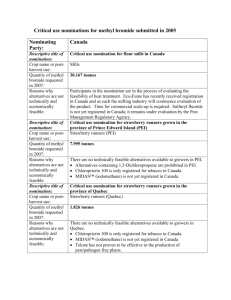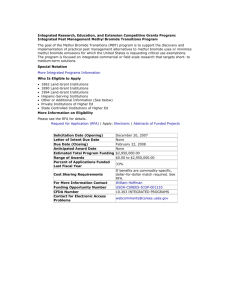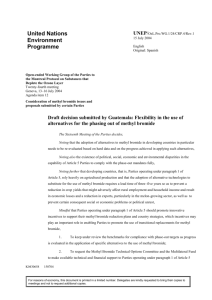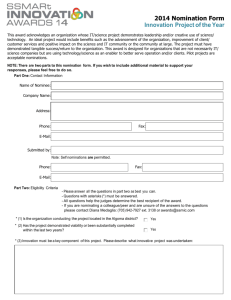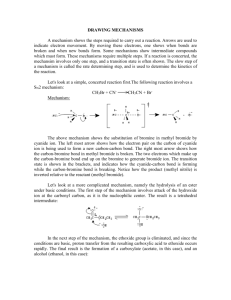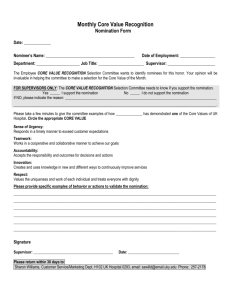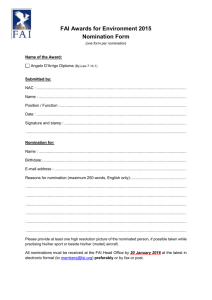Form 3 - Ozone Secretariat
advertisement
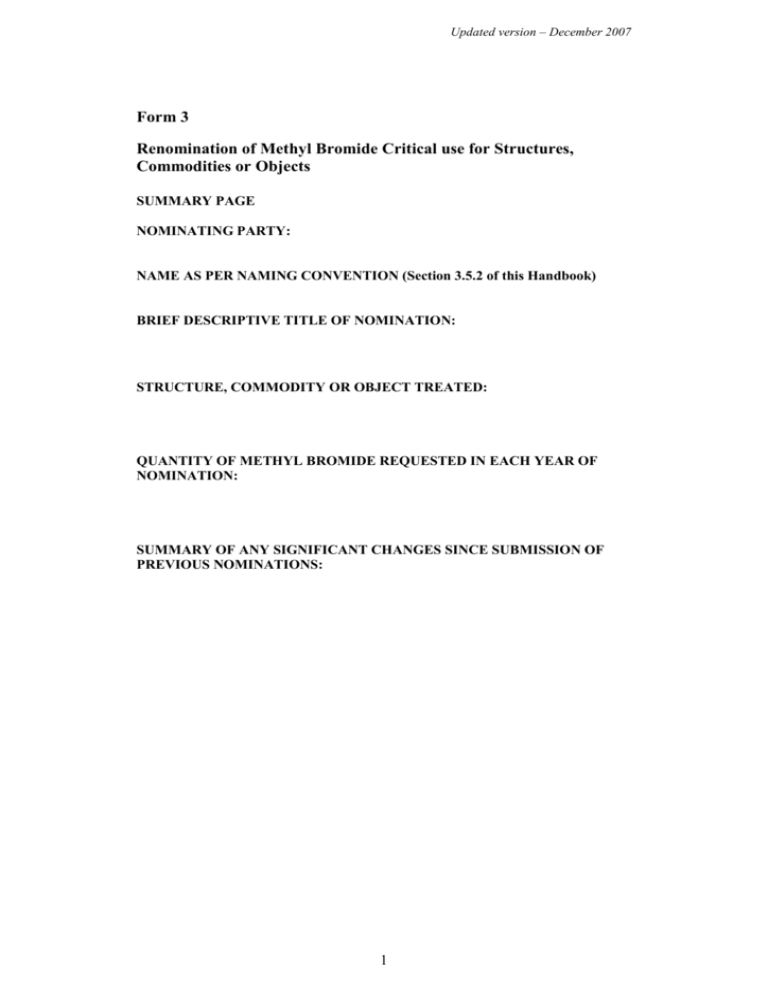
Updated version – December 2007 Form 3 Renomination of Methyl Bromide Critical use for Structures, Commodities or Objects SUMMARY PAGE NOMINATING PARTY: NAME AS PER NAMING CONVENTION (Section 3.5.2 of this Handbook) BRIEF DESCRIPTIVE TITLE OF NOMINATION: STRUCTURE, COMMODITY OR OBJECT TREATED: QUANTITY OF METHYL BROMIDE REQUESTED IN EACH YEAR OF NOMINATION: SUMMARY OF ANY SIGNIFICANT CHANGES SINCE SUBMISSION OF PREVIOUS NOMINATIONS: 1 Updated version – December 2007 Details on this page are similar to those for new nominations requested under Decision Ex. I/4(7), for posting on the Ozone Secretariat website under Decision Ex. I/4(8) This form is to be used by holders of single-year exemptions to reapply for a subsequent year’s exemption for Structures, Commodities and Objects only (for example, a Party holding a single-year exemption for 2006 and/or 2007 seeking further exemptions for 2008). It does not replace the format for requesting a criticaluse exemption for the first time. In assessing nominations submitted in this format, TEAP and MBTOC will also refer to the original nomination on which the Party’s first-year exemption was approved, as well as any supplementary information provided by the Party in relation to that original nomination. As this earlier information is retained by MBTOC, a Party need not re-submit that earlier information. NOMINATING PARTY CONTACT DETAILS: Contact Person: Title: Address (include city/code numbers): Telephone: Fax: E-mail: Following the requirements of Decision IX/6 paragraph (a)(1) [insert name of Party] has determined that the specific use detailed in this Critical Use Nomination is critical because the lack of availability of methyl bromide for this use would result in a significant market disruption. Yes No 2 Updated version – December 2007 Signature Name Date Title: CONTACT OR EXPERT(S) FOR FURTHER TECHNICAL DETAILS Contact/Expert Person: Title: Address (include city/code numbers): Telephone: Fax: E-mail: LIST OF DOCUMENTS SENT TO THE OZONE SECRETARIAT IN OFFICIAL NOMINATION PACKAGE List all paper and electronic documents submitted by the Nominating Party to the Ozone Secretariat. 1. PAPER DOCUMENTS: Title of paper documents and appendices 3 No. of pages Date sent to Ozone Secretariat Updated version – December 2007 2. ELECTRONIC COPIES OF ALL PAPER DOCUMENTS: ) 4 No. of kilobytes Date sent to Ozone Secretariat Updated version – December 2007 Part A: SUMMARY INFORMATION 1. NOMINATING PARTY AND NAME AS PER NAMING CONVENTION Para 3.5.2 of Handbook: 2. BRIEF DESCRIPTIVE TITLE OF NOMINATION: 3. YEAR FOR WHICH EXEMPTION SOUGHT: 4. SUMMARY OF ANY SIGNIFICANT CHANGES SINCE SUBMISSION OF PREVIOUS NOMINATIONS (e.g. changes to requested exemption quantities, successful trialling or commercialisation of alternatives, etc.) Part B: TRANSITION PLANS Provision of a National Management Strategy for Phase-out of Methyl Bromide is a requirement under Decision Ex. I/4(3) for nominations after 2005. The time schedule for this Plan is different than for CUNs. Parties may wish to submit Section 21 separately to the nomination. 5. IF NOT ALREADY PROVIDED, DESCRIBE MANAGEMENT STRATEGIES THAT ARE IN PLAVE OR PROPOSED TO ELIMINATE THE USE OF METHYL BROMIDE FOR THE NOMINATED CRITICAL USE INCLUDING: (1) Measures to avoid any increase in methyl bromide consumption except for unforeseen circumstances; (2) Measures to encourage the use of alternatives through the use of expedited procedures, where possible, to develop, register and deploy technically and economically feasible alternatives; 5 Updated version – December 2007 (3) Provision of information on the potential market penetration of newly deployed alternatives and alternatives which may be used in the near future, to bring forward the time when it is estimated that methyl bromide consumption for the nominated use can be reduced and/or ultimately eliminated; (4) Promotion of the implementation of measures which ensure that any emissions of methyl bromide are minimized; (5) Actions to show how the management strategy will be implemented to promote the phase-out of uses of methyl bromide as soon as technically and economically feasible alternatives are available, in particular describing the steps which the Party is taking in regard to subparagraph (b) (iii) of paragraph 1 of Decision IX/6 in respect of research programmes in non-Article 5 Parties and the adoption of alternatives by Article 5 Parties. Part C: TRANSITION ACTIONS Responses should be consistent with information set out in the applicant’s previously-approved nominations regarding their transition plans, and provide an update of progress in the implementation of those plans. In developing recommendations on exemption nominations submitted in 2003, 2004, 2005 and 2006, the Technology and Economic Assessment Panel in some cases recommended that a Party should explore the use of particular alternatives not identified in a nomination’ transition plans. Where the Party has subsequently taken steps to explore use of those alternatives, information should also be provided in this section on those steps taken. Questions 6 - 10 should be completed where applicable to the nomination. Where a question is not applicable to the nomination, write “N/A”. 6. TRIALS OF ALTERNATIVES Where available, attach copies of trial reports. Where possible, trials should be comparative, showing performance of alternative(s) against a methyl bromide-based standard i. Description and implementation status: ii. Outcomes of trials: Include any available data on outcomes from trials that are still underway. Where applicable, complete the table included at Appendix I identifying comparative disease ratings and yields with the use of methyl bromide formulations and alternatives. 6 Updated version – December 2007 iii. Impact on critical use nomination/required quantities: For example, provide advice on any reductions to the required quantity resulting from successful results of trials. iv. Actions to address any delays/obstacles in conducting or finalising trials: 7. TECHNOLOGY TRANSFER, SCALE-UP, REGULATORY APPROVAL FOR ALTERNATIVES i. Description and implementation status: ii. Outcomes achieved to date from technology transfer, scale-up, regulatory approval: iii. Impact on critical use nomination/required quantities: For example, provide advice on any reductions to the required quantity resulting from successful progress in technology transfer, scale-up, and/or regulatory approval. 7 Updated version – December 2007 iv. Actions to address any delays/obstacles: 8. COMMERCIAL SCALE-UP /DEPLOYMENT, MARKET PENETRATION OF ALTERNATIVES i. Description and implementation status: ii. Impact on critical use nomination/required quantities: For example, provide advice on any reductions to the required quantity resulting from successful commercial scale-up/deployment and/or market penetration. iii. Actions to address any delays/obstacles: 9. CHANGES TO TRANSITION PROGRAM If the transition program outlined in the Party’s original nomination has been changed, provide information on the nature of those changes and the reasons for them. Where the changes are significant, attach a full description of the revised transition program. 10. OTHER BROADER TRANSITION ACTIVITIES Provide information in this section on any other transitional activities that are not addressed elsewhere. This section provides a nominating Party with the opportunity to report, where applicable, on any additional activities which it may have undertaken to encourage a transition, but need not be restricted to the circumstances and activities of the individual nomination. Without prescribing specific activities that a nominating Party should address, and noting that 8 Updated version – December 2007 individual Parties are best placed to identify the most appropriate approach to achieve a swift transition in their own circumstances, such activities could include market incentives, financial support to exemption holders, labelling, product prohibitions, public awareness and information campaigns, etc. 9 Updated version – December 2007 Part D: REGISTRATION OF ALTERNATIVES Progress in registration of a product will often be beyond the control of an individual exemption holder as the registration process is the responsibilityof the manufacturer or supplier of the product. The speed with which registration applications are processed also can falls outside the exemption holder’s control, resting with the nominating Party. Consequently, this section requests the nominating Party to report on any efforts it has taken to assist the registration process, but noting that the scope for expediting registration will vary from Party to Party. 11. PROGRESS IN REGISTRATION Where the original nomination identified that an alternative’s registration was pending, but it was anticipated that one would be subsequently registered, provide information on progress with its registration. Where applicable, include any efforts by the Party to “fast track” or otherwise assist the registration of the alternative. 12. DELAYS IN REGISTRATION Where significant delays or obstacles have been encountered to the anticipated registration of an alternative, the exemption holder should identify the scope for any new/alternative efforts that could be undertaken to maintain the momentum of transition efforts, and identify a time frame for undertaking such efforts. 13. DEREGISTRATION OF ALTERNATIVES Describe new regulatory constraints that limit the availability of alternatives. For example, changes in buffer zones, new township caps, new safety requirements (affecting costs and feasibility), and new environmental restrictions such as to protect ground water or other natural resources. Where a potential alternative identified in the original nomination’s transition plan has subsequently been deregistered, the nominating Party would report the deregistration including reasons for it. The nominating Party would also report on the impact of the deregistration (if any) on the exemption holder’s transition plan and on the proposed new or alternative efforts that will be undertaken by the exemption holder to maintain the momentum of transition efforts. 10 Updated version – December 2007 Part E: IMPLEMENTATION OF MBTOC/TEAP RECOMMENDATIONS The Methyl Bromide Technical Options Committee and the Technology and Economic Assessment Panel may recommended that a Party explore and, where appropriate, implement alternative systems for deployment of alternatives or reduction of methyl bromide emissions. Where the exemptions granted by a previous Meeting of the Parties included conditions (for example, where the Parties approved a reduced quantity for a nomination), the exemption holder should report on progress in exploring or implementing recommendations. Information on any trialling or other exploration of particular alternatives identified in TEAP recommendations should be addressed in Part C. 14. USE/EMISSION MINIMISATION MEASURES Where a condition requested the testing of an alternative or adoption of an emission or use minimisation measure, information is needed on the status of efforts to implement the recommendation. Information should also be provided on any resultant decrease in the exemption quantity arising if the recommendations have been successfully implemented. Information is required on what actions are being, or will be, undertaken to address any delays or obstacles that have prevented implementation. Part F: ECONOMIC FEASIBILITY 15. ECONOMIC FEASIBILITY OF ALTERNATIVES – METHODOLOGY Where a nomination has been previously approved on the basis of the economic infeasibility of alternatives, provide information where applicable on any significant changes to the underlying economic factors, including if appropriate any modification to the economic methodology used in assessing infeasibility. Partial budget analysis showing gross and net returns for methyl bromide and the next best alternatives is a widely accepted approach. Analysis should be supported by discussions identifying what costs and revenues change and why. The following measures may be useful desciptors of the economic outcome using methyl bromide or alternatives. Parties may identify additional measures. Regardless of the methodology used, this section should explain why the calculated measures with the alternatives are levels that indicate the alternative is not economically feasible. (a) (b) (c) (d) The purchase cost per kilogram of methyl bromide and of the alternative; Gross and net revenue with and without methyl bromide, and with the next best alternative; Percentage change in gross revenues if alternatives are used; Absolute losses per hectare/cubic metre if alternatives are used; 11 Updated version – December 2007 (e) (f) (g) Losses per kilogram of methyl bromide requested if alternatives are used; Losses as a percentage of net cash revenue if alternatives are used; Percentage change in profit margin if alternatives are used. Part G: CHANGES TO QUANTITY OF METHYL BROMIDE REQUESTED This section seeks information on any changes to the Party’s requested exemption quantity. 16. CHANGES IN USAGE REQUIREMENTS Provide information on the nature of changes in usage requirements, including whether it is a change in dosage rates, the number of hectares or cubic metres to which the methyl bromide is to be applied, and/or any other relevant factors causing the changes. 17. RESULTANT CHANGES TO REQUESTED EXEMPTION QUANTITY Quantity requested for previous nomination year: __________________ Quantity recommended for previous nomination year by Methyl Bromide Technical Options Committee/ Technology and Economic Assessment Panel: __________________ Quantity approved by Parties for previous nomination year: __________________ Quantity required for year to which this reapplication refers: __________________ 12
